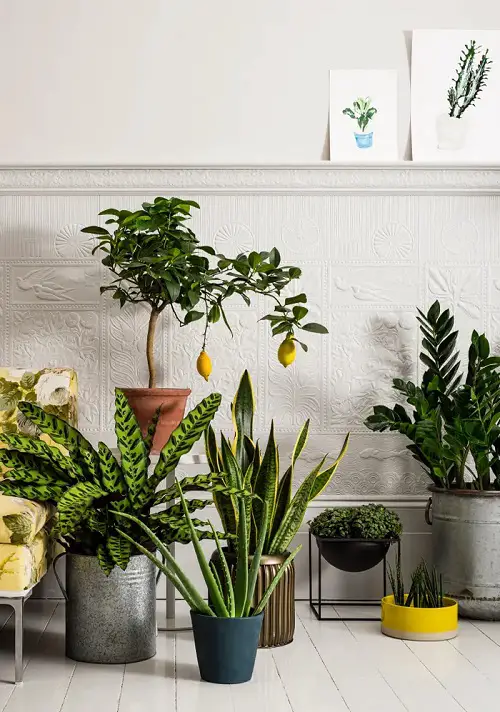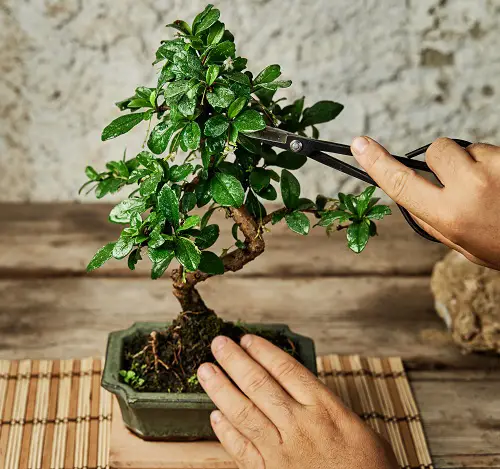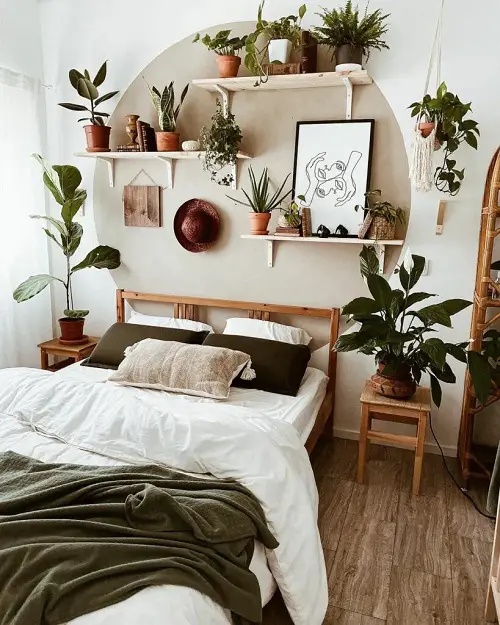These Houseplant Myths will help you separate the facts and share valuable tips for taking care of indoor plants in the right way!
We are going to bust some houseplant myths in this article that will clear many doubts off many gardeners and indoor plant growers!
Blue Sunflower: Is it a Reality or a Myth?
Houseplant Myths
Myth 1: Bigger Pots Mean Faster Growth
Myth: Plants in large pots grow faster.
Truth: The pot size should match the plant’s needs to prevent overwatering and root rot.
What to Do: You should select a pot that’s one size larger than the rootball of the plant, ensuring it’s not too large or too small.
Myth 2: Distilled Water is Best
Myth: Distilled water is best for houseplants.
Truth: While distilled water can be used, it lacks essential minerals.
What to Do: You should use regular tap water if it’s not hard and chlorine-infused. Also, let it sit for at least 24 hours to allow the hardness to settle down.
Is Distilled Water Good for Plants | Watering Plants With Distilled Water
Myth 3: Yellow Leaves Equal Death
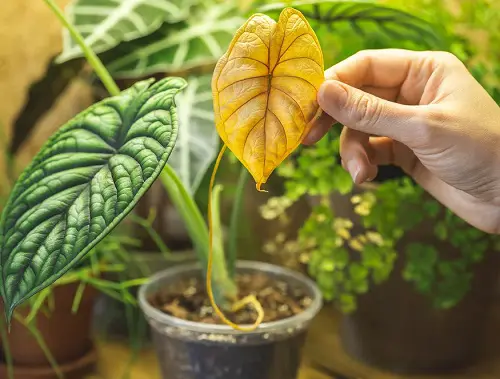
Myth: Yellow leaves always signify a dying plant.
Truth: Yellowing can result from overwatering, underwatering, or other issues.
What to Do: Adjust your watering routine, ensuring you’re not overwatering or underwatering. Look around for pests or diseases and take care of them.
Myth 4: All Bugs Are Bad
Myth: All bugs are harmful to plants.
Truth: Many bugs, like ladybugs and lacewings, are beneficial, aiding in pest control.
What to Do: Identify harmful pests and get rid of them by inviting beneficial ones. You can also go for companion planting. Using harsh chemical pesticides that harm beneficial bugs is a big NO!
Can ZZ Plant Cause Cancer? Reality or Myth?
Myth 5: Houseplants Purify the Air Completely
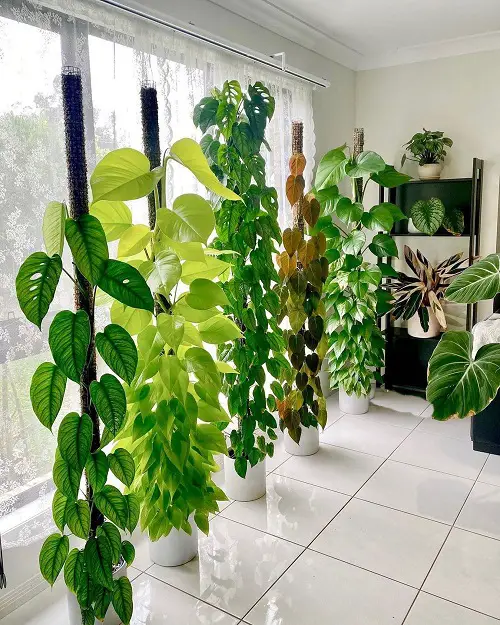
Myth: Houseplants can completely purify the air.
Truth: While they enhance air quality, they’re not a substitute for proper ventilation.
What to Do: Many plants can improve the air quality, but these effects are on a small level, especially in closed spaces. Place plants (The more, the better) strategically to maximize their impact on air quality.
Myth 6: Misting Boosts Humidity
Myth: Misting significantly increases humidity.
Truth: While it provides temporary relief, a humidifier is more effective for maintaining consistent humidity.
What to Do: Get a humidifier for better humidity control. Also, when misting, you need to focus on the plant’s foliage, avoiding excessive water on the soil to prevent overwatering.
Myth 7: Pots Need a Stone Layer
Myth: Pots require a thick layer of stones or bark for drainage.
Truth: A thick layer of rocks can hinder drainage.
What to Do: Skip this all together and just use a well-draining potting mix for proper drainage.
Why You Should Not Add Gravels to Pots: Busting an Old Myth
Myth 8: Bathrooms Are Ideal for All Plants
Myth: Bathrooms are ideal for all plants due to high humidity.
Truth: Restrooms may have temperature fluctuations harmful to some plants.
What to Do: Pick plants that suit your specific bathroom conditions for thriving greenery. Consider placing humidity-loving plants like Pothos, Aglaonema, and Croton.
Myth 9: Plants Need Winter Rest
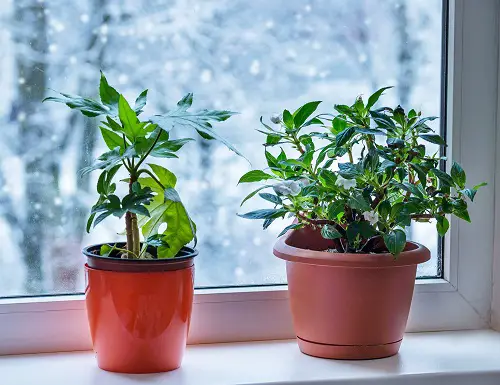
Myth: All plants need rest in winter.
Truth: Some plants go dormant, but not all plants follow this.
What to Do: Know your plants! Research your plants’ winter needs and adjust care accordingly. Also, provide adequate warmth and light to plants that do not go dormant during winter.
Myth 10: Fertilize With Every Watering
Myth: Fertilizing with every watering is beneficial.
Truth: Overfertilizing can lead to nutrient burn and other issues.
What to Do: Using a balanced fertilizer diluted to 1/4 of its strength once in 4-5 weeks is more than enough.
Some Famous Succulent Myths Busted!
Myth 11: Annual Repotting is Necessary

Myth: Houseplants require annual repotting.
Truth: Repotting should only occur when the plant outgrows its pot or the soil is depleted.
What to Do: Only repot when you see the roots popping out of the topsoil or from the drainage hole at the bottom of the pot.
Myth 12: Water on a Schedule
Myth: A fixed watering schedule suits all plants.
Truth: The watering depends on the needs of the plant and the conditions of your home.
What to Do: Check the soil moisture and water accordingly. Adjust your watering based on humidity levels, room temperature, and the season.
How to Bottom Water Your Plants + Houseplants that Love Bottom Watering
Myth 13: Use Only Organic Products
Myth: Only organic products are safe for plants.
Truth: There is a little bit of truth in this. Organic products are good, but some synthetic ones are also effective and safe.
What to Do: Pick products based on your plant’s specific needs, whether organic or synthetic. Weigh the pros and cons of each product type and use them judiciously.
8 Common Indoor Plant Myths You Should Know About
Myth 14: More Fertilizer for Better Growth
Myth: More fertilizer means faster growth.
Truth: The truth is that too much fertilizing can harm plants.
What to Do: Follow the recommended instructions on the fertilizer package. The best rule to follow is once a month after diluting the feed to 1/2 strength.
Myth 15: Pruning Equals Growth
Myth: Pruning is necessary for all plants to encourage growth.
Truth: While pruning shapes plants and encourages growth, not all plants require it.
What to Do: Learn about your plants’ pruning needs before grabbing pruning shears. Make sure you prune selectively to remove dead or overgrown parts, promoting healthy growth.
Myth 16: Houseplants Need No Light

Myth: Some believe that certain houseplants can survive in complete darkness (No Light).
Truth: All plants need some light. You should know that no plant can tolerate a space with zero light, such as a windowless bathroom.
What to Do: If there is little light in the room where you’re keeping the plant, you should add LED grow lights so they receive ample light for photosynthesis. Even “low-light” labeled plants like Pothos and ZZ plants grow better in medium to bright light.
Find out some surprising benefits of using human hair in the garden here
Myth 17: Leaf Shine is Best for Clean Leaves
Myth: Using leaf shine products is best for cleaning houseplant leaves.
Truth: Applying any substance, like commercial leaf shine products, may block the stomata on the leaf surface, hindering evaporation.
What to Do: Don’t use these products. Wiping with a damp cloth with a few drops of milk is enough to maintain the aesthetics of the leaves.
8 Milk Uses in the Garden Proven by Science
Myth 18: Succulents Need Little Water

Myth: Succulents only require a minimal amount of water.


